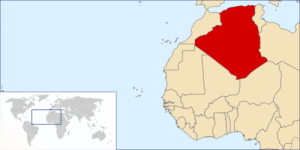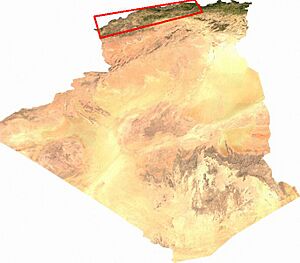Algerian wine facts for kids

Algerian wine is wine made in Algeria, a country in North Africa. Wine has been made there for a very long time. Its history goes back to ancient times with the Phoenicians and Romans. Before Algeria became independent in the 1960s, Algerian wine was a big part of the world's wine trade. Algeria still makes wine today, with many wineries operating.
Contents
History of Algerian Wine
Ancient Roots of Winemaking
Winemaking in Algeria began with the Phoenicians. These ancient traders settled in the area. Later, the Roman Empire continued making wine there. But when Muslim groups took over North Africa in the 600s and 700s, wine production slowed down. This was because Islamic rules often do not allow alcohol.
French Rule and a Boost in Production
In 1830, France took control of Algeria. Vineyards were replanted to make wine for the French people living there. In the mid-1800s, a disease called phylloxera destroyed many vineyards in France. Algerian wine then became very important. It filled the gap in France.
Winemakers from Germany also came to Algeria. They brought new ways to make wine. This helped improve the quality of Algerian wine. Even after French vineyards recovered, Algerian wine was still used. It was often mixed with French wines to add color and strength.
Peak Production and Independence
The Algerian wine industry was at its best in the late 1930s. Over 4,000 square kilometers (about 1,500 square miles) of land grew grapes. This produced more than 2,100 million liters (about 550 million US gallons) of wine. By the 1950s, Algeria, along with Tunisia and Morocco, made almost two-thirds of all wine traded worldwide. Algerian red wine was mostly used for blending with wines from southern France. The main grape at this time was Carignan.
By 1962, when Algeria became independent, many areas had special quality status from France. After independence, the wine industry faced challenges. France greatly reduced how much wine it bought from Algeria. This made Algerian wineries look for new buyers. In 1969, the Soviet Union agreed to buy a lot of wine.
Many Algerian government officials encouraged farmers to grow other crops. They suggested things like grains or table grapes instead of wine grapes. City growth also reduced the number of vineyards. At the start of the 21st century, people tried to restart the Algerian wine industry. But today, not much Algerian wine is sold internationally.
Climate and Wine Regions
Where Grapes Grow in Algeria
All of Algeria's vineyards are in the Hauts Plateaux region. This area stretches towards the border with Morocco. It is near the Mediterranean Sea. This region has a typical Mediterranean climate. This means it has mild winters and dry, hot summers. It is very similar to the southern wine regions of Spain.
Rainfall is about 600 millimeters (24 inches) in the eastern regions. It is about 400 millimeters (16 inches) in the western regions near Morocco. The main areas for wine production are in these provinces:
Algeria has an official organization for wine. It lists seven quality wine zones. These names can appear on Algerian wine labels.
- Coteaux de Tlemcen
- Monts du Tessalah
- Coteaux de Mascara
- Dahra hills
- Coteaux du Zaccar
- Médéa
- Aïn Bessem Bouira
Grapes and Wine Types
Main Grape Varieties
When Algerian wine production was at its highest, the main grapes were Carignan, Cinsaut, and Alicante Bouschet. Sometimes, wines made from these grapes were wrongly called "burgundy." This was even though they were not made from Pinot noir grapes.
Today, the main grape varieties are Clairette blanche and Ugni blanc. There are also smaller plantings of other grapes. These include Cabernet Sauvignon, Chardonnay, Merlot, Mouvedre, and Syrah.
See also
 In Spanish: Vino de Argelia para niños
In Spanish: Vino de Argelia para niños


